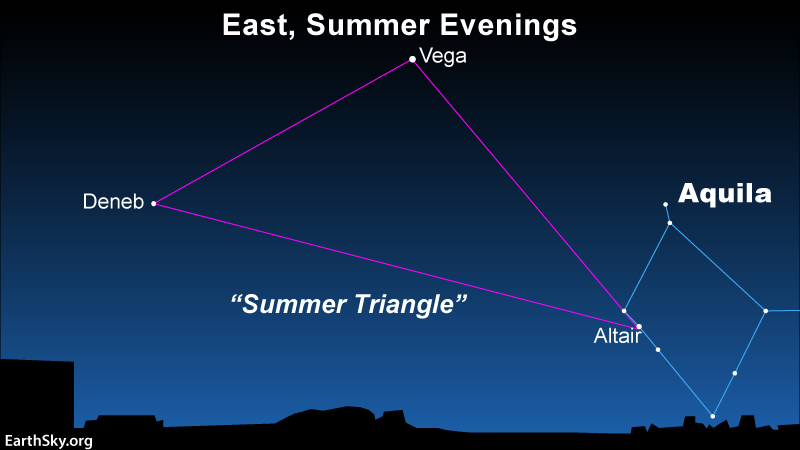
In the east after dark on these July evenings, look near the horizon for Altair, the brightest star in the constellation Aquila the Eagle. This is the bottom star of the Summer Triangle; that is, it’s the last of these three bright stars to ascend over the horizon. This star is 16.7 light-years from our sun and is one of the closest stars visible to the unaided eye.
You will recognize Altair by the two fainter stars on either side of it. In her classic book “The Friendly Stars” (1907), Martha Evans Martin described the three this way:
Then there comes a soft June evening, with its lovely twilight that begins with the last song of the woodthrush and ends with the first strenuous admonitions of the whippoorwill; and, almost as if it were an impulse of nature, one walks to the eastern end of the porch and looks for Altair. It is sure to be there smiling at one just over the tree-tops, with a bright companion on either side, the three gently advancing in a straight line as if they were walking the Milky Way hand in hand and three abreast.
And indeed the Great Rift of the summer Milky Way passes through the Summer Triangle, between the stars Vega and Altair. In dark skies in June, July and August, you can see rich star fields with your binoculars on both sides of the Great Rift.
In modern western culture, Altair is probably best known for being the home star system of the aliens in the 1956 science fiction film “Forbidden Planet”. But in Asian cultures, Altair and the star Vega figure in one of the most beautiful of all stories of the night sky. In Japan, for example, Vega is sometimes called Tanabata (or Orihime), a celestial princess or goddess. She falls in love with a mortal, Kengyu (or Hikoboshi), represented by the star Altair. Read the rest of the story here.
The whole Summer Triangle area is great to observe with binoculars or in dark skies with just your eyes. If you like finding hidden pictures, get set to find a Coathanger, the North American Nebula (NGC7000) and the Ring Nebula (M57).

Our Summer Triangle series also includes:
Part 1: Vega and its constellation Lyra
Part 2: Deneb and its constellation Cygnus
Bottom line: The star Altair in Aquila the Eagle appears in the east on July evenings. You’ll recognize it by the 2 fainter stars on either side of it.











